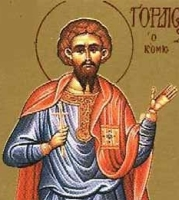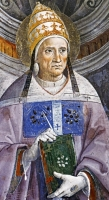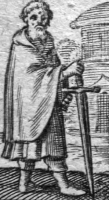Enoch the Patriarch
Also known as
Chanoch, Henoch, Henok
Additional Memorials
• 22 January (Coptic Church)
• 19 July (his assumption in the Coptic Church)
• 7 July on some calendars
• 30 July on some calendars
• Tuesday after Easter (Syriac menologies)
Profile
Old Testament Patriarch, a descendant of Seth and ancestor of Noah. He is mentioned by other writers in the Old and New Testaments, and an extensive library of legends has grown up around him.
Saint Genevieve
பாரிஸ் நகர புனிதர் ஜெனிவீவ்
பாரிஸ் நகரின் பாதுகாவல் புனிதர்:
(Patron Saint of Paris)
பிறப்பு: கி.பி 422
நாந்தெர்ரே, ஃபிரான்ஸ்
(Nanterre, France)
இறப்பு: கி.பி 512 (வயது 90)
பாரிஸ், ஃபிரான்ஸ்
(Paris, France)
ஏற்கும் சமயம்:
ரோமன் கத்தோலிக்க திருச்சபை
(Roman Catholic Church)
கிழக்கு மரபுவழி திருச்சபை
(Eastern Orthodox Church)
நினைவுத் திருநாள்: ஜனவரி 3
பாதுகாவல்: பாரிஸ்
புனிதர் ஜெனிவீவ், ரோமன் கத்தோலிக்கம், மற்றும் கிழக்கு மரபுவழி திருச்சபைகளின் புனிதரும், பாரிஸ் நகரின் பாதுகாவலரும் ஆவார். இவரது நினைவுத் திருநாள், ஜனவரி மாதம், 3ம் தேதி ஆகும்.
பாரிஸ் நகரின் மேற்கு புறநகர் பகுதியான "நாந்தெர்ரே" (Nanterre) எனுமிடத்தில் பிறந்த இவர், "ஆக்ஸெர்ரியின் ஜெர்மானஸ்" (Germanus of Auxerre) மற்றும் "ட்ராய்ஸின் லூபஸ்" (Lupus of Troyes) ஆகிய ஆயர்களின் சந்திப்புக்குப் பின்னர் பாரிஸுக்கு குடிபெயர்ந்தார். அங்கே, கிறிஸ்தவ பணி வாழ்க்கைக்கு தன்னை அர்ப்பணித்தார். கி.பி. 451ம் ஆண்டில், அவர் ஒரு "பிரார்த்தனை மராத்தான்" க்கு தலைமை தாங்கினார். அது, பாரிஸ் நகருக்கு படையெடுத்து வந்த "ஹன்ஸ்" (Huns) ஆட்சியாளர் "அட்டிலா" (Attila) என்போரை நகரத்திலிருந்து திசைதிருப்பி, பாரிஸைக் காப்பாற்றியதாகக் கூறப்படுகிறது.
கி.பி. 464ம் ஆண்டில், ஜெர்மானிய மன்னர் "முதலாம் சில்டெரிக்" (Childeric I) நகரத்தை முற்றுகையிட்டபோது, இவர் நகரத்திற்கும், அதன் முற்றுகையாளர்களுக்கும் இடையில் ஒரு இடைத்தரகராக செயல்பட்டு, உணவு சேகரித்து, தனது கைதிகளை விடுவிப்பதற்காக மன்னர் சில்டெரிக்கை சமாதானப்படுத்தினார்.
"நாந்தெர்ரே" (Nanterre) எனுமிடத்தில், "செவெரஸ்" (Severus) மற்றும் "ஜெரோன்சியா" (Geroncia) ஆகியோருக்கு பிறந்த இவர், ஒரு விவசாய பெண் என்று வர்ணிக்கப்படுகிறார். இவரது வாழ்க்கை சரிதத்தை ஒரு சமகாலத்தவரால் எழுதப்பட வேண்டும் என்று இருந்தாலும், ஜெனீவியின் சரிதத்தை வரலாற்றிலிருந்து பிரிக்க முடியாது.
பிரிட்டனுக்குச் செல்லும் வழியில், நாந்தேரேயில் தங்கிய "ஆக்ஸெர்ரேயின்" ஆயர், "ஜெர்மானஸை" (Germanus of Auxerre) சந்தித்த ஜெனீவீவ், தாம் கடவுளுக்காக மட்டுமே வாழ விரும்புவதாக அவரிடம் தெரிவித்தார். அவர் அவரை ஊக்குவித்ததன் காரணமாக, பதினைந்து வயதிலேயே ஜெனீவீவ் கன்னியாஸ்திரி ஆனார். தமது பெற்றோர் இறந்ததன் பிறகு, அவர் பண்டைய பாரிஸ் நகரின் "லூடேஷியா" (Lutetia) எனுமிடத்தில், தனது ஞானத்தாயுடன் வசிக்கச் சென்றார். அங்கு அந்த இளம் பெண், தனது பக்தி மற்றும் தொண்டு பணிகளில் ஈடுபாடு கொண்டதற்காகப் போற்றப்பட்டார். மேலும் நோன்பு நடவடிக்கைகளை கடைப்பிடித்தார். இதில் இறைச்சியைத் தவிர்ப்பது மற்றும் வாரத்தில் இரண்டு முறை மட்டுமே விரதத்தை விடுத்தல் ஆகியவற்றை பின்பற்றினார். அவருடைய நோன்பு நடவடிக்கைகளை குறைக்க வைப்பது தங்கள் கடமை என்று அவரது சபையின் தலைமை நினைக்கும் வரை, சுமார் முப்பது வருடகாலம் அவர் இந்த வாழ்க்கை நடைமுறைகளை பின்பற்றினார். பொறாமை கொண்டவர்களிடமிருந்தும் வஞ்சக எண்ணம் கொண்டவர்களிடமிருந்தும், தமது நடவடிக்கைகளுக்கு எதிர்ப்பையும் விமர்சனத்தையும் சந்தித்தார்.
ஜெனிவீவுக்கு, பரலோக புனிதர்கள் மற்றும் தேவதூதர்களின் தரிசனம் அடிக்கடி கிட்டியதாகவும் கூறப்படுகிறது. அவளுடைய எதிரிகள் அவரை ஒரு ஏரியில் மூழ்கடிக்க சதி செய்யும்வரை, தமக்கு கிட்டிய தரிசனங்களையும் தீர்க்கதரிசனங்களையும் அவர் அறிவித்தார். ஆயர் ஜெர்மானஸின் (Germanus) தலையீட்டின் மூலம், அவர்களின் பகை இறுதியாக முறியடிக்கப்பட்டது. பாரிஸின் ஆயர், கடவுளுக்கு அர்ப்பணிக்கப்பட்ட கன்னியரின் நலனைக் கவனிக்க அவரை நியமித்தார் மேலும், அவரது அறிவுறுத்தல் மற்றும் முன்மாதிரியால் அவர் அவர்களை உயர்ந்த புனிதத்தன்மைக்கு அழைத்துச் சென்றார்.
கி.பி. 451ம் ஆண்டு, பாரிஸில் அட்டிலாவின் கீழ் ஹன்ஸ் தாக்குதலுக்கு சற்று முன்பு, ஜெனீவீவ் மற்றும் ஜெர்மானஸின் திருத்தொண்டர் ஆகியோர், பாரிஸில் பீதியடைந்த மக்களை தப்பி ஓடாமல் பிரார்த்தனை செய்ய தூண்டினர். ஜெனீவீவியின் பிரார்த்தனைகளின் பரிந்துரைகள் காரணமாக, பாரிஸ் நகருக்குப் பதிலாக, அட்டிலாவின் இராணுவம் "ஆர்லியன்ஸுக்குச்" (Orléans) சென்றதாகக் கூறப்படுகிறது. கி.பி. 464ம் ஆண்டு, "சைல்டெரிக்" பாரிஸை முற்றுகையிட்டபோது, ஜெனீவீவிவ் ஒரு படகில் முற்றுகை பகுதிகள் வழியாக ஒரு படகில் பயணித்து, "ட்ராய்ஸ்" நகருக்குச் சென்று, நகரத்திற்கு வேண்டிய தானியங்களைக் கொண்டு வந்தார். போர்க் கைதிகளின் நலனுக்காக, சைல்டெரிக்கிடம் அவர் கெஞ்சினார். மேலும் அவரிடமிருந்து சாதகமான பதிலையும் பெற்றதாக கூறப்படுகின்றது. அவரது செல்வாக்கின் காரணமாக, சைல்டெரிக் மற்றும் க்ளோவிஸ் ஆகியோர், குடிமக்கள் மீது தங்களுக்கு பழக்கப்படாத கருணை காட்டினர்.
புனிதர் டெனிஸ் மீது (Saint Denis) ஒரு பக்தியைகொண்டிருந்த ஜெனிவீவ், அவரை மிகவும் நேசித்தார் மேலும் புனிதரது மீபொருட்களை வைப்பதற்காக, அவரது நினைவாக ஒரு சிற்றாலயத்தை அமைக்க விரும்பினார். கி.பி. சுமார் 475ம் ஆண்டு, ஜெனீவ் புனிதர் டெனிஸ் அடக்கம் செய்யப்பட்ட இடத்தில் சில நிலங்களை வாங்கினார். மற்றும் அண்டை குருக்களை, அவர்களின் ஆன்மீக முயற்சிகளுக்காக அதனை பயன்படுத்தும்படி உற்சாகப்படுத்தினார். இவர்களது இந்த சிறிய சிற்றாலயம், கி.பி. ஐந்தாம் மற்றும் ஆறாம் நூற்றாண்டுகளில் புகழ்பெற்ற புனித யாத்திரைக்கான இடமாக மாறியது.
ஃபிராங்கிஷ் மன்னரான (King of the Franks) "முதலாம் க்ளோவிஸ்" (Clovis I), நிர்மாணித்த மடாலயத்தில் மறைப்பணியாற்றி வந்த ஜெனிவீவ், அவரது மரணத்தின் பின்னர், அங்கேயே அடக்கம் செய்யப்பட்டார்.
Also known as
Genovefa
Additional Memorial
28 October (translation of relics)
Profile
When she was seven years old, Genevieve met Saint Germanus of Auxerre on his way to England. Germain befriended her because of her insistence on wanting to live her life for God, and prophesied her future sanctity. She took the veil at age 15. Prophesied invasions and disasters for Paris. Could read consciences and calm the possessed. When Paris was besieged by the Franks, she encouraged its defense, organized prayers for God's protection of the city, and led an expedition for food to relieve the siege. Caused a church to be built on the tomb of Saint Denis. In 1129, the procession of her relics through Paris is believed to have ended an epidemic.
Born
422 at Nanterre near Paris, France
Died
• 500 at Paris, France
• interred in the church of Saints Peter and Paul in Paris
• relics destroyed in 1871
Patronage
• against plague
• against disasters
• against fever
• French security forces (chosen in 1962)
• Paris, France
• WACs
• Women's Army Corps
Representation
• bread (from feeding the people)
• candle
• cattle
• girl restoring eyesight to her mother
• keys
• shepherdess holding a candle which the devil is trying to extinguish and angels are helping to protect
• shepherdess with a coin suspended around her neck
Feast of the Holy Name of Jesus
Additional Memorials
• 14 January (Franciscans, Carmelites, Augustinians)
• 15 January (Dominicans)
• 1 January (Eastern Churches; Lutheran)
• 7 August (Anglican)
Article
A remembrance and celebration of the conferral of the Holy Name of Jesus. It is celebrated on 3 January. A separate votive Mass under this title is found in the revised Roman Missal, and may be used for an annual celebration (e.g. titular of a Church), or as an expression of devotion which is part of the tradition and spirituality of a religious order. It was formerly listed as the Sunday between 1 and 6 January, if one occurs. Instituted in the 15th century by the bishops of Germany, Scotland, England, and Belgium. It was extended to the universal Church in 1721. There is a commemoration in the Mass of the Octave of Saint Stephen if the feast is kept on the second, of Saint John on the third, and of the Holy Innocents on the fourth of January.
Patronage
• Raleigh, North Carolina, diocese of
• Pratovecchio, Italy
Saint Blitmund of Bobbio
Also known as
• Blitmund of St-Valéry
• Blitmund of Leuconay
• Blitmund of Picardië
• Blidmundus, Blimond, Blimont, Blimundus, Blithmundus, Blithumund, Blitmond, Gogus
Profile
Born to the nobility, as a young man, Blitmund moved to northern France to live as a hermit along the River Somme in Leuconay. In 611 he built a chapel and two cells in the area. He brought a hanged man back to life, which caused the spread of his reputation as a miracle worker and holy man. This, in turn, led to would-be spiritual students gathering around him and living in a nearby monastery.
For unexplained reasons, Blitmund lost the use of his legs; he was healed of this paralysis c.615 by his friend and spiritual teacher Saint Valery of Leucone. Blitmund then became a monk at Valery‘s monastery. When the house was destroyed by local pagans c.620, Blitmund led a group of the monks to Bobbio, Italy where they established the community in a monastery established by Saint Columban, spiritual teacher of Valery. Spritiual student of Saint Attalas of Bobbio.
Around 627, Blitmund returned to the area of Leucone, France where he lived for a year as a hermit before receiving permission to build another abbey. He served as its abbot, and made Leucone a site of pilgrimage, piety and learning, and a hub for evanglization that eventually converted the region. The area was later known as Saint-Valéry, and now the village of Saint-Valery-sur-Somme.
Born
late 6th-century in the Dauphiné region of modern France
Died
• 660 of natural causes
• relics later enshrined in Leucone in a building he and Saint Valery had built
Saint Kuriakose Elias Chavara
புனிதர் குரியாக்கோஸ் எலியாஸ் சாவரா
CMI மற்றும் CMC ஆகிய சபைகளின் நிறுவனர்/ சிரிய கத்தோலிக்கரின் தலைமை ஆட்சியர்:
பிறப்பு: ஃபெப்ரவரி 10, 1805
கைநக்கரி, குட்டநாடு, திருவிதாங்கூர் இராச்சியம் (தற்போதைய ஆலப்புழா மாவட்டம், கேரளா, இந்தியா)
இறப்பு: ஜனவரி 3, 1871 (வயது 65)
கூனம்மாவு, கொச்சி இராச்சியம் (தற்போதைய எர்ணாகுளம் மாவட்டம், கேரளா, இந்தியா)
ஏற்கும் சமயம்:
கத்தோலிக்க திருச்சபை (சிரோ மலபார் திருச்சபை)
அருளாளர் பட்டம்: ஃபெப்ரவரி 8, 1986
திருத்தந்தை இரண்டாம் ஜான் பவுல்
புனிதர் பட்டம்: நவம்பர் 23, 2014
திருத்தந்தை ஃபிரான்சிஸ்
முக்கிய திருத்தலங்கள்:
புனித சூசையப்பர் ஆலயம் – மன்னானம், கோட்டயம், கேரளா, இந்தியா.
புனித ஃபிலோமினா ஃபோரேன் ஆலயம் - கூனம்மாவு, கொச்சி, கேரளா, இந்தியா.
பாதுகாவல்: அச்சுத் தொழில், ஊடகம், இலக்கியம், சபைகள்
நினைவுத் திருவிழா: ஜனவரி 3 (சிரோ மலபார்)
புனிதர் குரியாக்கோஸ் எலியாஸ் சாவரா, இந்தியாவின் கேரளா மாநிலத்தில் பிறந்தவரும், கத்தோலிக்க திருச்சபையில் சீரோ மலபார் வழிபாட்டு முறையைச் சார்ந்தவரும் ஆவார்.
இவர் இந்தியாவிலேயே முதன்முறையாகத் தொடங்கப்பட்ட கத்தோலிக்க ஆண் துறவியர் சபையின் நிறுவனர்களுள் ஒருவர் ஆவர். அவர் தொடங்கிய சபை “மாசற்ற மரியாளின் கார்மேல் சபை” (Carmelites of Mary Immaculate (C.M.I.) என்று அழைக்கப்படுகிறது. இது சீரோ மலபார் வழிபாட்டுப் பிரிவின் ஓர் அமைப்பு ஆகும். அச்சபையின் முதல் தலைவராகவும் அவர் பணியாற்றினார். பின்னர் அவர் பெண் துறவியருக்கென்று ஒரு சபையைத் தொடங்கினார். அது “கார்மேல் அன்னை சபை” (Congregation of the Mother of Carmel (C.M.C.) என்று அழைக்கப்படுகிறது.
வாழ்க்கை வரலாறு:
குரியாக்கோஸ் எலியாஸ் சாவறா, இந்தியாவின் கேரள மாநிலத்தில் “கைநக்கரி” (Kainakary) என்னும் கிராமத்தில் “நசரானி கிறிஸ்தவர்கள்” (Nasrani Christian) என்று அழைக்கப்படுகின்ற “புனித தோமா கிறிஸ்தவ” குடும்பம் ஒன்றில் பிறந்தார். அவருடைய தந்தை “இகோ குரியாக்கோஸ் சாவரா” (Iko Kuriakose Chavara) ஆவார். தாயார் “மரியம் தோப்பில்” (Mariam Thoppil) ஆவார். குரியாக்கோஸ் எலியாஸ் சாவரா பிறந்த நாள் 1805ம் ஆண்டு, ஃபெப்ரவரி மாதம், 10ம் நாளாகும். “சென்னம்காரி” (Chennamkary) ஊரில் அமைந்துள்ள புனித யோசேப்பு சீரோ மலபார் கோவிலில் 1805ம் ஆண்டு, ஃபெப்ரவரி மாதம், 17ம் நாளில் அவருக்குத் திருமுழுக்கு வழங்கப்பட்டது. குரியாக்கோஸ் என்னும் பெயர் சிரிய-அரமேய மொழியிலிருந்து வருகிறது.
சொந்த ஊரில் தொடக்கக் கல்வி பயின்ற இவர், 1818ம் ஆண்டு, “பள்ளிப்புறத்தில்” (Pallipuram) அமைந்திருந்த குருமடத்தில் இணைந்தார். அந்த குருமடத்தின் அதிபராக, (Rector) அருட்தந்தை “பாலக்கல் தோமா மல்பான்” (Palackal Thoma Malpan) இருந்தார். குரியாக்கோஸ் எலியாஸ் சாவரா, 1829ம் ஆண்டு, நவம்பர் மாதம், 29ம் நாள், குருத்துவ அருட்பொழிவு பெற்றார்.
குருவான பிறகு குரியாக்கோஸ் வேறு இரண்டு குருக்களோடு சேர்ந்து துறவற வாழ்க்கை வாழ்ந்தார். அவர்கள், “பாலக்கல் தோமா மல்பான்” (Palackal Thoma Malpan) மற்றும் “போருக்கர தோமா கத்தனார்” (Porukara Thoma Kathanar) ஆவர். அவர்கள் தொடங்கிய துறவு சமூகத்தின் பெயர் “மாசற்ற மரியாளின் ஊழியர்” என்பதாகும். மன்னானம் நகரில் முதல் இல்லத்தின் அடிக்கல்லை தோமா கத்தனார் நட்டார். அவர் 1846ம் ஆண்டிலும், அதற்கு முன் தோமா மல்பான் 1841ம் ஆண்டிலும் இறந்தார்கள். 1855ம் ஆண்டு, டிசம்பர் மாதம், 8ம் நாள் குரியாக்கோஸும், அவரோடு வேறு பத்து குருக்களும் கார்மேல் சபை மரபுக்கு இணங்க வார்த்தைப்பாடு கொடுத்தார்கள். குரியாக்கோஸ், மன்னானம் மடத்திற்குத் தலைவராக நியமனமானார். "காலணியற்ற கார்மேல் சபை” (Order of Discalced Carmelites) என்னும் சபையின் பொதுநிலைப் பிரிவாக அச்சபை ஏற்கப்பட்டது.
சமூக சீர்திருத்தர்:
குரியாக்கோஸ் சமயத் துறையில் மட்டுமன்றி சமூகத் துறையிலும் சிறந்து விளங்கிய ஒரு சீர்திருத்தர் ஆவார். உயர்ந்த சாதி என்று கருதப்பட்ட பிரிவில் அவர் பிறந்திருந்தாலும் அவர் தாழ்ந்த சாதியினர் என்று கருதப்பட்ட மக்களுக்கு கல்வியறிவு வழங்கப்பட வேண்டும் என்று பாடுபட்டார்.
1846ம் ஆண்டு, அவர் மன்னானத்தில் ஒரு கல்விக்கூடம் தொடங்கினார். சிரிய கத்தோலிக்கரின் தலைவராக இருந்தபோது, 1864ம் ஆண்டில், ஒவ்வொரு ஆலயத்திலும் ஒரு கல்விக் கூடம் தொடங்கி அனைவருக்கும் இலவசக் கல்வி கிடைக்க ஏற்பாடு செய்தார்.
குரியாக்கோஸ் முயற்சியால் பள்ளிக்கூடங்களில் மாணவர்களுக்கு நண்பகல் உணவு வழங்கப்பட்டது. இந்த வழக்கத்தைத் திருவிதாங்கூர் அரசும் பின்னர் கேரள அரசும் கடைப்பிடித்தன.
இந்திய கத்தோலிக்க திருச்சபையில் முதன்முறையாக அச்சுக்கூடத்தை ஏற்படுத்தியவர் குரியாக்கோஸ். அது மன்னானத்தில் நிறுவப்பட்டது. அந்த அச்சுக்கூடத்திலிருந்து வெளிவந்த முதல் மலையாளப் பத்திரிகை “தீபிகா”.
திருச்சபை அளவில் பணி:
கேரள கத்தோலிக்க திருச்சபையில் பொதுநிலையினருக்கு தியானங்கள் வழங்குவதற்கு குரியாக்கோஸ் ஏற்பாடு செய்தார். கத்தோலிக்க பக்தி முயற்சிகளை வளர்த்தார். செபமாலை, சிலுவைப்பாதை, நற்கருணை ஆராதனை போன்ற பக்தி முயற்சிகள் பரவ வழிவகுத்தார்.
ஆண்களுக்கென்று ஒரு துறவியர் சபை, பெண்களுக்கென்று ஒரு துறவியர் சபை என்பவற்றைக் குரியாக்கோஸ் நிறுவினார். பெண்களும் ஆண்களுக்கு நிகரான விதத்தில் கல்வியறிவு பெற வேண்டும் என்ற கருத்துடைய குரியாக்கோஸ் பெண்களுக்கான துறவற சபையை 1866ம் ஆண்டு நிறுவினார்.
இறப்பு:
குரியாக்கோஸ், கூனம்மாவு என்ற ஊரில் 1871ம் ஆண்டு, ஜனவரி மாதம், 3ம் நாள் உயிர் துறந்தார். அவருடைய உடலின் மீபொருட்கள் மன்னானம் ஊரில் உள்ள புனித சூசையப்பர் ஆலய மடத்தில் 1889ம் ஆண்டும், மே மாதம், 24ம் நாளிலிருந்து காக்கப்படுகிறது.
அவருடைய நினைவுத் திருவிழா அவர் இறந்த நாளாகிய ஜனவரி 3ம் நாள் கொண்டாடப்படுகிறது.
புனிதர் பட்டம்:
குரியாக்கோசை நோக்கி வேண்டியதன் பயனாக பல புதுமைகள் நிகழ்ந்ததாகக் கூறப்படுகிறது. இந்தியாவின் முதல் புனிதராகக் கருதப்படுகின்ற புனித அல்போன்சா என்பவர் 1936ம் ஆண்டு வழங்கிய கூற்றுப்படி, குரியாக்கோஸ் இரண்டுமுறை அல்போன்சாவுக்குக் காட்சியளித்து அவருடைய நோய் தணித்தார். குரியாக்கோஸுக்குப் புனிதர் பட்டம் வழங்குவதற்கான மறைமாவட்டத் தயாரிப்பு 1955ம் ஆண்டு, சங்கனாச்சேரியில் தொடங்கியது. 1984ம் ஆண்டு, ஏப்ரல் மாதம், 7ம் நாள் திருத்தந்தை இரண்டாம் ஜான் பவுல் குரியாக்கோசின் சிறப்புப் பண்புகளை ஏற்று அவருக்கு “வணக்கத்துக்குரியவர்” என்னும் பட்டம் கொடுத்தார்.
1986ம் ஆண்டு, திருத்தந்தை இரண்டாம் ஜான் பவுல் இந்தியாவுக்கு வருகை தந்த வேளையில், கோட்டயம் நகரில் ஃபெப்ரவரி மாதம், 8ம் நாள் குரியாக்கோசுக்கு “அருளாளர்” பட்டம் வழங்கினார்.
2014ம் ஆண்டு, ஏப்ரல் மாதம், 3ம் நாள், குரியாக்கோஸ் வழியாக நிகழ்ந்த புதுமைகள் திருச்சபைத் தலைமைப் பீடத்தால் ஏற்கப்பட்டன.
திருத்தந்தை ஃபிரான்சிஸ், 2014ம் ஆண்டு, நவம்பர் மாதம், 23ம் நாள் கிறிஸ்து அரசர் பெருவிழாவின் தருணத்தில், வத்திக்கான் நகர புனித பேதுரு பேராலய வளாகத்தில் நிகழ்ந்த திருப்பலியின்போது குரியாக்கோஸ் எலியாஸ் சாவராவுக்குப் புனிதர் பட்ட அருட்பொழிவு வழங்கினார். அப்போது, குரியாக்கோஸ் ஏற்படுத்திய பெண் துறவியர் சபைக்குத் தலைவியாகப் பணியாற்றியிருந்த “யூப்ரேசியா எலுவத்திங்கல்” (Euphrasia Eluvathingal) என்பவருக்கும் புனிதர் பட்டம் வழங்கப்பட்டது.
Also known as
• Cyriacus Elias Chavara
• Cyriac Elias Chavara
• Kuriakose of the Holy Family
Profile
Studied with a Hindu teacher until age 10, and learned a variety of languages and regional dialects. Entered the seminary in 1818; ordained on 29 November 1829. Co-founder and first prior-general of the Congregation of the Carmelites of Mary Immaculate. The main work of the Congregation is education aiming at the intellectual, social, economic, moral and spiritual advancement of people, especially women and children; it works today in eight countries with almost 5,000 members. Kuriakose made his religious profession in the Congregation in 1855. Vicar-general for the Syro-Malabar church in 1861. Defended ecclesial unity which was threatened by schism by the consecration of Nestorian bishops in his area. Worked to renew the faith in Malabar. Co-founder of the Congregation of the Sisters of the Mother of Carmel in 1866. Known as a man of prayer with a devotion to the Eucharist and the Virgin Mary.
Born
10 February 1805 at Kainakary, Kersala, India
Died
• 3 January 1871 at Koonammuva, India of natural causes
• relics transferred to Mannanam in 1889
Canonized
• 23 November 2014 by Pope Francis
• his canonization miracle involved the cure of an eye disorder suffered by a girl named Maria in 2007
Saint Fintan of Doon
Also known as
Fiontan, Fintanus
Profile
Son of Pipan and Aes; brother of Saint Finlugh. Spiritual student of Saint Comgall at Bangor Abbey. Abbot at Doon, Limerick, Ireland. A holy well dedicated to him is still venerated at Doon. Many miracle stories were attached to him over the years.
Born
Irish
Died
6th century in Ireland of natural causes
Patronage
Doon, Ireland
Representation
monk with sickles or wheat (legend says that to prove the power of Christianity, he had a leperwheat ready for harvest, which he then baked into bread for the lepers)
Saint Finlugh of Derry
Also known as
Finlag, Finlug, Fionnlugh, Finlogh, Finloghait, Finlay
Profile
Son of Pipan and Aes; brother of Saint Fintan of Doon. Spiritual student of Saint Columba of Iona in Scotland. Abbot in a Columban monastery in County Derry, Ireland.
Born
Irish
Died
6th century in Ireland of natural causes
Saint Gordius of Cappadocia
Also known as
• Gordius of Caesarea
• Gordius the Centurian
Additional Memorial
2 March (Syrian Orthodox)
Profile
Soldier in Caesarea, Cappadocia. Convert to Christianity. Dismissed from the army as his religion made his loyalties questionable to the authorities. Lived as a desert hermit. During the persecutions of Diocletian, he turned himself over to the authorities so he could publicly proclaim his faith. Martyr.
Died
beheaded in 304
Pope Saint Antherus
Also known as
Anteros, Anterus, Antheros
Additional Memorial
5 August (Orthodox)
Profile
Son of Romulus. His family seems to have orginally been from Greece. Served as 19th Pope for about six weeks. Started the Vatican library to preserve documents concerning the early martyrs. Martyred in the persecutions of Maximus Thrax when he refused to relinquish court records of the persecutions.
Born
Petilia Policastro, Italy
Papal Ascension
21 November 235
Died
• martyred 3 January 236
• buried in the catacombs at the Cemetery of Saint Callistus, Rome, the first pope buried in the papal crypt
• relics re-discovered in 1854
Saint Hymnemodus of Saint-Maurice
Also known as
• Hymnemodus of San-Moritz
• Enemodus, Himnemond, Hymnemode, Hymnodus, Hynnemond, Ymnemodus
Profile
Official in the court of King Gundobad of Burgundy. Feeling a call to the religious life, Hymnodus entered the monastery of Grigney in Vienne, France; he was later chosen abbot of the house. In 515, he was appointed abbot of the monastery of Saint Moritz at the site of the massacre of the Theban Legion. With royal support and financing, the monastery expanded and in later centuries became a major religious center and pilgrimage site.
Born
455 in Gaul (modern France), probably in the area of Burgundy
Died
3 January 516 of natural causes
Saint Daniel of Padua
Profile
Jewish convert. Deacon to Saint Prosdocimus of Padua, and assisted in his missionary work. Martyed for his efforts during the persecutions of Marcus Aurelius.
Died
• nailed to a table to die of shock and blood loss in 168 at Padua, Italy
• relics re-discovered c.1000 and found incorrupt
• relics solemnly enshrined on 3 January 1064
Patronage
• lost articles
• prisoners
• women whose husbands are at war
• Padua, Italy
Representation
• deacon holding a towel and laver to indicate his service to his bishop
• palm of martyrdom
Saint Bertilia of Mareuil
Also known as
Bertilia of Marolles
Additional Memorial
8 October (translation of relics)
Profile
Born to the Frankish nobility, the daughter of Ricomer and Gertrude. Noted in her youth for her piety and charity. Married to Goutland, another Frankish noble noted for his own piety. Widow. She built a church dedicated to Saint Amandus of Maastricht, and moved into an adjoining cell where she lived as an anchoress the rest of her days.
Born
Belgium
Died
• 687 in Mareuil, Belgium of natural causes
• buried in the church of Saint-Amand in Mareuil
• re-interred in 1081
• relics enshrined on 8 October 1288
Saint Imbenia
Additional Memorials
• 29 April (procession of her statue in Cuglieri, Italy)
• 30 April (translation of relics)
Profile
Pious young woman martyred in the persecutions of Diocletian.
Died
• c.300 on Sarda (modern Shurdhah Island, Albania)
• interred in the church of San Lussorio
• relics re-discovered in 1628, and moved to the Basilica Insigne Collegiate Church of Santa Maria della Neve in Cuglieri, Italy
Patronage
Cuglieri, Italy
Blessed William Vives
Profile
Mercedarian friar at Barcelona, Spain. Prior of his house. At one point he became involved in political maneuvers involving both Church and State authorities; it led to civil protection and benefits to the convent. Wrote biographies of Saint Peter Nolasco and Blessed Maria de Cervellón; they were used in the canonization process.
Died
• early 15 century of natural causes
• buried at the monastery at Barcelona, Spain
Saint Theogenes of Cyzicus
Also known as
Teogene, Théogène
Profile
Priest. Bishop of Parios, Asia Minor. Ordered to join the imperial Roman army during the reign of emperor Licinius, he refused as it would require him to sacrifice to idols. Arrested, he was imprisoned without food for 40 days; he prayed for and converted some of soldiers, and survived the sentence. Tortured and executed. Martyr.
Died
drowned in 320 at Cyzicus on the Hellespont
Saint Zosimus of Cilicia
Additional Memorial
4 January (Orthodox; Armenian,; Syrian)
Profile
Tortured for his faith in Cilicia (part of modern Turkey) in the persecutions of Diocletian. His heroic suffering was the cause for the conversion of Saint Athanasius. He survived the persecutions to become a hermit for the remainder of his life. Because of his suffering and willingness to die for the faith, he is often listed as a martyr.
Saint Theopemptus of Nicomedia
Also known as
Heopompus, Teopempto, Theopompus, Theopontus
Additional Memorial
27 December (Armenian)
Profile
Bishop of Nicomedia, Bithynia (in modern Turkey). Converted Saint Theonas. Martyred in the persecutions of Diocletian.
Died
284
Saint Peter of Palestine
Also known as
• Peter Balsam
• Peter Aulanus
• Petrus Balsamus
• Pierre Basalme
Profile
Imprisoned, tortured and martyred for his faith.
Born
Palestine
Died
crucified c.311 in the region of Greece and Albania
Saint Athanasius of Cilicia
Profile
A witness to the torture of Zosimus of Cilicia in the persecution of Diocletian. The courage and faith of Zosimus caused Athanasius to convert. He was then tortured along with Zosimus. He survived the persecutions to become a hermit for the remainder of his life. Because of his suffering and willingness to die for the faith, he is often listed as a martyr.
Saint Theonas
Also known as
Synesius, Teonas
Additional Memorials
• 5 January (Orthodox)
• 19 January (Armenian)
Profile
Pagan magician. Convert, brought to Christianity by Saint Theopemptus of Nicomedia. Martyred in the persecutions of Diocletian.
Died
284
Saint Melorius
Also known as
Meilleur, Melar, Melior, Meliorus, Melon, Melor, Melorus, Mylor
Additional Memorial
1 October (translation of relics)
Profile
Venerated in Amesbury, Wiltshire, England and in Quimper, Brittany, France.
Born
Cornwall, England
Blessed Arnold Wala
Profile
Premonstratensian monk. Canon of the monastery of Saint Cornelius in Ninove, Belgium. Prior of the monastery for 40 years. Abbot of the house.
Born
early 12th century
Died
1190 of natural causes
Saint Bertille of Thuringia
Also known as
Bertilia
Profile
Born a princess. Married to Saint Walbert of Hainault. Mother of Saint Waltrude and Saint Aldegundis.
Died
c.660 of natural causes
Saint Florentius of Vienne
Also known as
Florens, Florent
Profile
Fourth century bishop of Vienne, France. Attended the Council of Valence in 374.
Died
377 in Vienne, France of natural causes
Saint Florentius of Vienne the Martyr
Profile
Third century bishop of Vienne, France. Exiled from Vienne by Emperor Gallienus. Martyred while in exile.
Died
c.275
Saint Cyrinus of Cyzicus
Profile
Soldier in the Roman army. Martyr.
Died
320 at Cyzicus on the Hellespont (part of modern Turkey)
Saint Eustadius
Also known as
Eustade
Profile
Pious 6th-century monk. Abbot of Saint-Benignus Abbey in Dijon, France. Great-uncle of Saint Gregory of Tours.
Saint Primus of Cyzicus
Profile
Soldier in the Roman army. Martyr.
Died
320 at Cyzicus on the Hellespont
Blessed Daniel of Himmerod
Also known as
Daniel Himmerod the Younger
Profile
Cistercian monk.
Saint Constant of Gap
Profile
Early sixth-century bishop of Gap, France. Attended the Council of Orange in 519.
Saint Lucian of Lentini
Also known as
Lucien
Profile
Bishop of Lentini, Sicily.
Saint Wenog
Profile
Listed on several liturgical calendars, but no details of his life have survived.
Born
Wales
Saint Salvator of Belluno
Profile
Bishop of Belluno, Italy. Miracle worker.
Martyrs of Africa
Profile
A group of Christians martyred together in Africa, date unknown, exact location unknown. We know nothing more than their names - Acuta, Candidus, Constantius, Eugenia, Firmus, Hilarinus, Lucida, Martial, Poenica, Possessor, Rogatianus and Statutianus.
Martyrs of Tomi
Profile
A group of Christians martyred together, date unknown. We know nothing more than their names - Claudon, Diogenius, Eugene, Eugentus, Pinna, Rhodes and Rhodo.
Died
at Tomi, Exinius Pontus, Moesia (modern Constanta, Romania)













